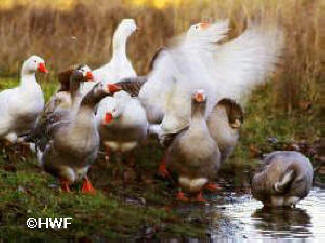
Tips for Selecting Your Breed(s)
We offer the following suggestions to help you make a wise choice in selecting the breed or breeds that are best suited to your needs. These recommendations are based on the production records and characteristics of the world-class strains we raise.
Eggs: If efficient egg production is your main goal, Cascades, Campbells, Harlequins, Hook Bills, and Runners should be given top priority.
Eggs & Meat: If you want ducks that combine good egg production and large meat birds of gourmet quality, we recommend Silver Appleyards and Saxonies. For high egg yields and excellent meat birds of medium size, Golden Cascades, Anconas, Harlequins and Magpies are hard to beat. Campbells, Hook Bills and Runners are lean, high-quality, medium-small meat birds when butchered in prime condition.
Mosquito & Pest Control, Pond Clean-up: All duck breeds help eradicate mosquito larva from waterways; slugs, snails and many insect pests from gardens; and algae slime and duck weed from ponds. The best foragers are Cascades, Campbells, Harlequins, Hook Bills, Runners, and the various bantam duck breeds we raise. In general, Appleyards (large), Cayugas and Saxony will do a good job, but do not cover such a large area and stay closer to home.
Weeder Geese: All breeds are used successfully to control grasses and some broad leaves. If soil compaction is an issue, avoid the heaviest breeds.
Geese in General: Choose the breed you're most attracted to. After raising all breeds over the course of 47 years, we've found that in most cases personality and temperament depend more on the individual bird and its environment than on the breed. To reduce the likelihood of aggressive behavior at maturity, we've found it helpful to work calmly around geese of all ages, to never tease them, and to not feed them from the hand.
Exhibition: For showing, order Show Quality day-olds or adults out of our special exhibition matings. Birds from our stock are winning major awards in Canada, Europe and the U.S., including Reserve Bird In Show at the 2005 Joint American Poultry Association-American Bantam Association National with 2800 entries and Best In show at the 2006 Joint National with 11,640 entries. Remember, not every offspring from even the best stock develop into show specimens. A good rule of thumb is to raise 2 to 3 young for every show bird desired.
Pilgrim Geese Relaxing At Pond's Edge
- Home
- Photo Gallery Home
- Adult Sales List 2017
- Breeds List
- Breed Selection Tips
- Duckling Price List
- Gosling Price List
- Hatchling Assortments
- Shipping Hatchlings
- Adult Birds Price List
- Shipping Adults
- Pick-Up Orders
- Ordering Information
- Order Form
- Recommended Reading
- Catalog Requests
- Contact Us
- Farm Visits